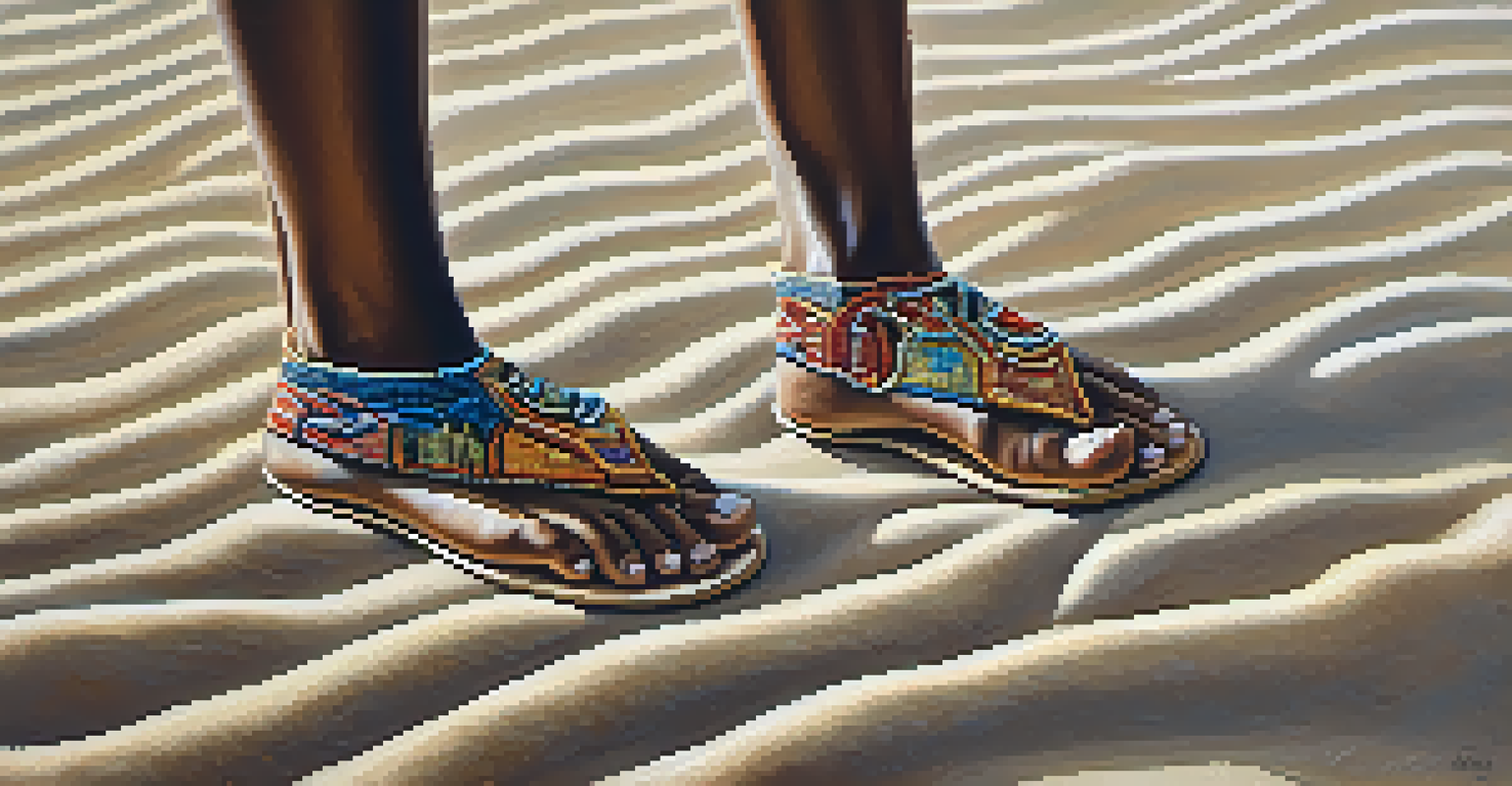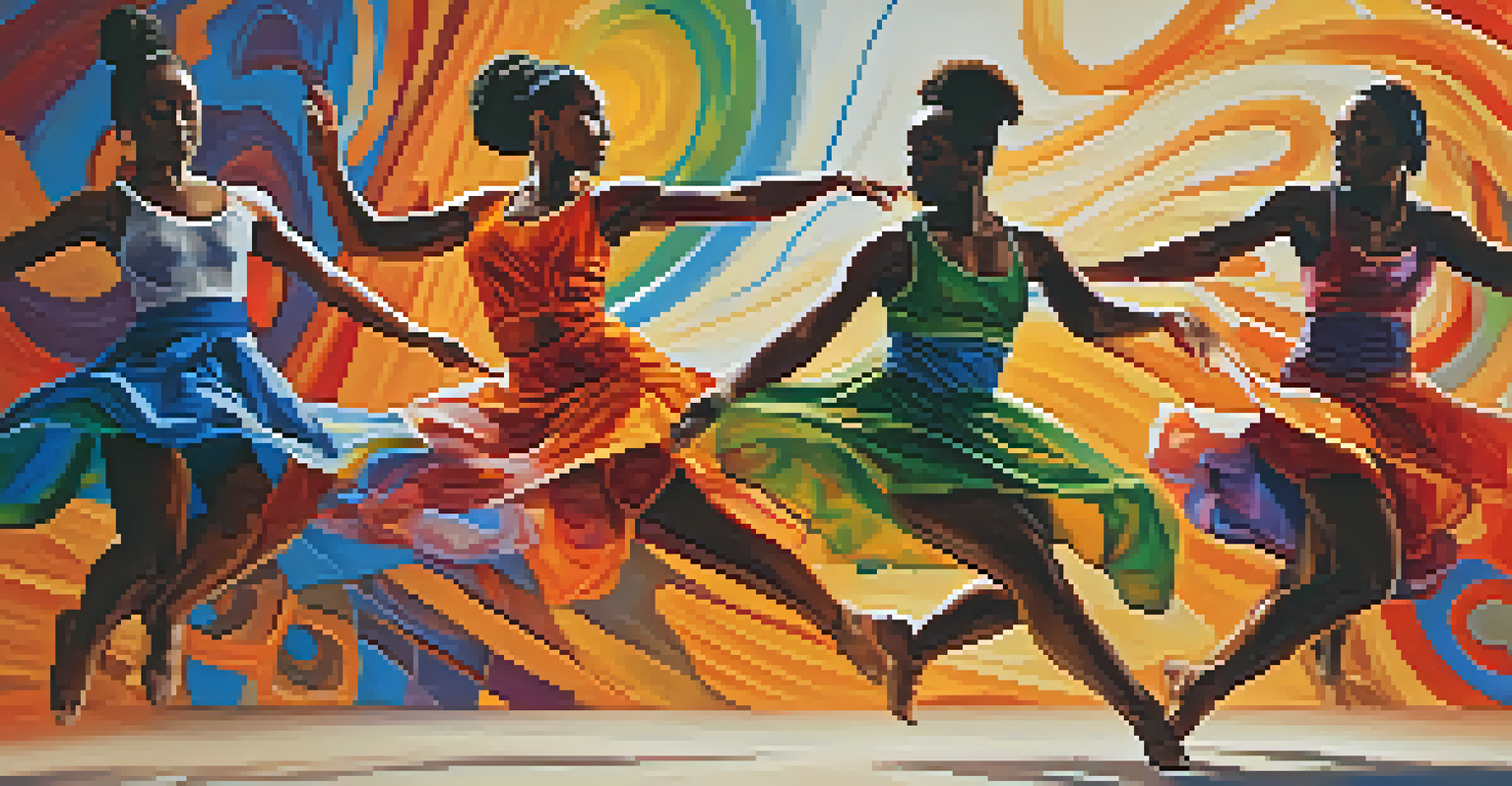The Influence of African Dance on Contemporary Performance Art

Understanding the Roots of African Dance
African dance is deeply rooted in the continent's diverse cultures and traditions, often serving as a form of storytelling and communication. Each movement carries significant meaning, reflecting the history, spirituality, and social values of various communities. Through vibrant rhythms and expressive gestures, these dances connect performers to their ancestors and heritage, creating a sense of belonging.
Dance is the hidden language of the soul.
The communal aspect of African dance is vital; it often involves participation from all ages and backgrounds, fostering unity and shared experience. Events like weddings, harvests, and rites of passage are celebrated through dance, emphasizing its role in cultural identity. This collective expression not only preserves traditions but also adapts to contemporary contexts, ensuring its relevance in today's world.
As we explore the evolution of dance, it's essential to recognize how these traditions have influenced modern performance art. Artists globally draw inspiration from African dance, incorporating its techniques and philosophies into their work. This blending of styles creates a rich tapestry of performance that honors the past while pushing artistic boundaries.
The Role of Rhythm and Movement in African Dance
Rhythm is the heartbeat of African dance, guiding the movements and energizing performers and audiences alike. Traditional African music often features complex polyrhythms, which influence the dance's dynamic nature. This rhythmic foundation encourages improvisation, allowing dancers to express their individuality while remaining rooted in cultural practices.

In many African dance forms, body movement goes beyond mere choreography; it conveys emotion, tells stories, and even addresses social issues. Dancers use their bodies as instruments, translating the music's intricacies into visual art. This deep connection between rhythm and movement is something contemporary performance artists are increasingly embracing, leading to innovative interpretations.
African Dance as Cultural Expression
African dance serves as a vital form of storytelling, preserving the history and social values of diverse communities.
Modern performance art often seeks to evoke a visceral response, and the rhythmic elements borrowed from African dance serve this purpose beautifully. By integrating these aspects, artists create a dialogue that resonates with audiences on a deeper level, bridging cultural gaps and fostering understanding through movement.
Fusion of African Dance with Contemporary Styles
The fusion of African dance with contemporary styles has led to exciting and innovative performances that captivate audiences. Artists like Alvin Ailey and Bill T. Jones have brilliantly merged African dance aesthetics with modern techniques, creating a unique and dynamic performance language. This cross-pollination of styles highlights the versatility and adaptability of African dance in the contemporary landscape.
The body says what words cannot.
In addition to established choreographers, emerging artists are experimenting with various dance forms, incorporating elements of hip-hop, ballet, and even street dance into their work. This blending not only showcases the richness of African dance but also encourages a dialogue between different cultures and artistic expressions. It reflects the global nature of today's art scene, where boundaries are increasingly blurred.
This fusion also allows for a broader representation of narratives and experiences, making contemporary performance art more inclusive. By embracing African dance, artists can tell stories that resonate with diverse audiences, inviting them to engage with and appreciate different cultural perspectives. This collaborative spirit enriches the art form as a whole.
Cultural Significance of African Dance in Performance Art
The cultural significance of African dance extends far beyond the stage; it serves as a vital means of preserving history and identity. Contemporary performance artists often draw upon these cultural narratives to create contextually rich pieces that resonate with audiences. By honoring African dance's roots, they not only pay homage to its origins but also highlight its relevance in today's artistic dialogue.
Furthermore, incorporating African dance into contemporary performances challenges stereotypes and misconceptions about African culture. Artists use their platforms to educate audiences about the depth and diversity of African traditions, fostering a greater appreciation for the continent's rich artistic heritage. This aspect is essential in an increasingly globalized world where cultural exchange is paramount.
Fusion with Contemporary Styles
The blending of African dance with modern techniques creates innovative performances that resonate with global audiences.
Through this cultural lens, performance art becomes a powerful tool for social commentary, addressing issues such as identity, migration, and community. By weaving African dance into their narratives, artists create a space for discussion and reflection, encouraging viewers to engage with complex themes in a meaningful way.
The Influence of African Dance on Dance Education
The impact of African dance can also be seen in dance education programs around the world. Many institutions now incorporate African dance styles into their curricula, offering students a broader understanding of global dance traditions. This exposure helps cultivate a more inclusive and diverse approach to dance training, allowing students to appreciate various cultural perspectives.
Learning African dance techniques equips students with essential skills such as improvisation, rhythm, and body awareness. These elements enhance their overall dance vocabulary, making them more versatile performers. Additionally, understanding the cultural context behind these movements fosters respect and appreciation for the art form, encouraging future artists to honor their roots.
As educators embrace African dance in their programs, they contribute to a legacy of cultural exchange and innovation. This practice not only enriches the students' experiences but also helps ensure that African dance continues to thrive in contemporary performance art, bridging generations and cultures.
The Global Reach of African Dance in Performance Art
The global reach of African dance is evident in various performance art forms, transcending geographical boundaries. From Broadway shows to international dance festivals, African-inspired performances are celebrated and recognized for their vibrancy and emotional depth. This widespread appeal speaks to the universal language of dance, connecting people through shared experiences and emotions.
Moreover, the growing popularity of African dance has led to increased collaboration between artists from different backgrounds. This cross-cultural exchange results in innovative performances that challenge traditional notions of dance and art. By bringing together distinct styles and perspectives, artists create a rich, multifaceted art form that resonates with diverse audiences worldwide.
Cultural Significance in Education
Incorporating African dance in educational programs fosters a diverse understanding of global dance traditions and cultural appreciation.
As African dance continues to influence contemporary performance art, it serves as a reminder of the power of cultural exchange. This artistic dialogue fosters understanding and appreciation of diverse traditions, ultimately enriching the global art community.
Future Directions for African Dance in Performance Art
As we look to the future, the role of African dance in performance art is poised to evolve even further. With an increasing number of artists and choreographers incorporating these elements into their work, we can expect to see more innovative interpretations that challenge conventional boundaries. This evolution is exciting, as it reflects the dynamic nature of both African dance and contemporary performance art.
Emerging technologies and digital platforms also present new opportunities for African dance to reach wider audiences. Virtual performances and online collaborations allow artists to share their work globally, breaking down geographical barriers. This accessibility not only promotes African dance but also encourages a more diverse and inclusive art scene.

Ultimately, the continued influence of African dance in contemporary performance art will depend on the commitment of artists to honor its roots while exploring new possibilities. By fostering a spirit of collaboration and innovation, the future of African dance in performance art looks bright, promising a rich tapestry of creativity and cultural exchange.